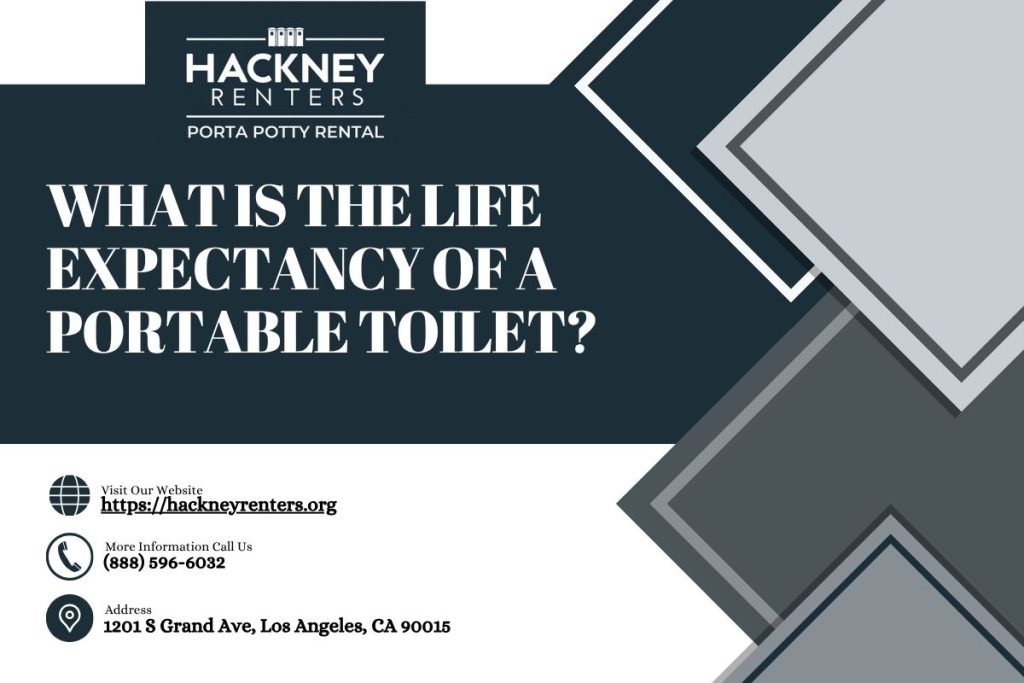Your portable toilet's life expectancy depends on usage intensity and maintenance quality. Standard units typically last 10-15 years under normal rental conditions, while heavy construction site deployment reduces lifespan to 7-10 years. Deluxe models with reinforced HDPE construction can provide up to 18 years of service. You'll enhance longevity through consistent maintenance schedules, proper chemical treatments, and protection from extreme weather. Regular inspections identify critical failure points before they compromise structural integrity, ensuring regulatory compliance throughout the operational lifecycle.

Standard portable toilets typically operate for 10-15 years under normal rental conditions, though this lifespan varies considerably based on usage intensity, maintenance protocols, and environmental exposure.
You'll find that units experiencing heavy construction site use may require replacement after 7-10 years, while those used for occasional events can exceed 15 years of service.
Manufacturing quality directly impacts durability. High-density polyethylene construction offers superior resistance to UV degradation and chemical damage compared to standard materials.
You can achieve significant cost savings by choosing quality units that meet ANSI/NSF standards.
Regular maintenance extends operational life substantially. Proper cleaning, timely repairs, and protective storage prevent premature deterioration.
Temperature extremes, frequent transport, and harsh chemicals accelerate wear patterns.
Strategic replacement planning optimizes your investment while ensuring compliance with health regulations.
See also: portable bathroom rental service
Under normal operating conditions, most portable toilets provide 12-14 years of reliable service when proper usage protocols and environmental controls are maintained. This timeframe assumes consistent maintenance schedules, appropriate chemical treatments, and protection from extreme weather conditions.
Your unit's longevity depends on several critical factors:
You'll enhance your investment by following manufacturer specifications and industry best practices. Quality units constructed with polyethylene materials resist cracking and warping better than those made with cheaper alternatives.
Professional servicing ensures peak performance throughout the operational lifecycle, providing the reliability and cost-effectiveness you need for your projects.
Construction materials serve as the foundation for understanding durability differences between portable toilet classifications. Standard units typically utilize high-density polyethylene (HDPE) construction with basic hardware components, while deluxe models incorporate reinforced structural elements and premium-grade materials.
| Feature | Standard Units | Deluxe Units |
|---|---|---|
| Wall Thickness | 3/16 inch HDPE | 1/4 inch reinforced HDPE |
| Hardware | Standard hinges/latches | Stainless steel components |
| Expected Lifespan | 8-12 years | 12-18 years |
You'll find that deluxe units resist UV degradation more effectively through improved polymer formulations and integrated stabilizers. Their superior construction translates to reduced maintenance frequency and lower long-term operational costs. Standard models meet basic regulatory requirements while deluxe versions exceed industry standards for structural integrity. This performance differential directly impacts your investment's return through extended service intervals and reduced replacement scheduling.
Beyond material specifications and unit classifications, environmental conditions and operational practices significantly impact the lifespan of your portable toilet investment.
Temperature extremes accelerate material degradation, while consistent maintenance schedules extend operational life. You'll enhance longevity by implementing systematic care protocols that address structural integrity and sanitation requirements.
Critical longevity factors include:
Your proactive approach to these variables directly correlates with extended service life and reduced replacement costs.
The operational demands you place on portable toilets directly determine their maintenance requirements and total lifespan. High-traffic installations require weekly pumping and thorough sanitization protocols, while low-use units can operate efficiently with bi-weekly service intervals.
You can enhance longevity through consistent preventive maintenance, including regular tank pumping, chemical treatment monitoring, and structural inspections.
Heavy usage accelerates wear patterns on door mechanisms, seat assemblies, and ventilation systems. You must establish systematic cleaning schedules that address both visible contamination and bacterial buildup.
Neglecting maintenance cycles results in premature component failure and costly replacements.
Your service frequency directly correlates with unit performance. Well-maintained portable toilets typically deliver 7-10 years of reliable operation, while neglected units may require replacement within 3-5 years.
Proper maintenance protects your investment while ensuring regulatory compliance and user satisfaction.

Environmental forces exert significant stress on portable toilet structures, directly impacting their operational lifespan. You'll find that UV radiation, temperature fluctuations, precipitation, and wind exposure create cumulative damage that accelerates deterioration beyond standard wear patterns.
Weather-resistant materials and strategic placement extend service life, but you can't eliminate environmental impact. Consider these critical exposure factors:
You'll enhance durability by selecting units with UV-stabilized materials and implementing proper anchoring systems that resist environmental stresses while maintaining regulatory compliance standards.
While environmental factors inevitably affect the longevity of portable toilets, systematic maintenance protocols can significantly extend operational life and improve your investment return.
You'll optimize durability through regular structural inspections, identifying stress fractures before they compromise unit integrity. Implement weekly deep-cleaning procedures using EPA-approved disinfectants to prevent corrosive buildup and bacterial deterioration.
Replace seals, gaskets, and door hardware proactively rather than reactively. You'll avoid costly emergency repairs by maintaining detailed service logs documenting component wear patterns.
Proper ventilation system maintenance prevents moisture accumulation that accelerates material degradation.
Store units in covered areas during off-seasons to minimize UV exposure and temperature fluctuations. Apply protective coatings annually to vulnerable surfaces.
These disciplined maintenance practices typically double standard operational lifespans while maintaining compliance with health department regulations and user satisfaction standards.
Among all maintenance protocols, consistent cleaning and servicing schedules form the backbone of portable toilet longevity programs.
You'll enhance your investment by implementing systematic maintenance intervals that prevent deterioration and guarantee regulatory compliance.
Professional servicing involves thorough protocols that directly impact structural integrity:
You're protecting your freedom to operate efficiently when you establish these maintenance rhythms.
Regular servicing prevents costly emergency repairs and extends operational life considerably beyond standard expectations through proactive intervention strategies.
Three critical failure points determine when immediate repairs become non-negotiable: door mechanism malfunction, ventilation system breakdown, and tank seal compromise.
You'll maintain operational independence by establishing proactive replacement schedules rather than reactive emergency responses. Your maintenance protocol should prioritize component longevity through systematic interventions.
| Component | Replacement Interval | Failure Impact |
|---|---|---|
| Door latches | 18-24 months | Access denial |
| Ventilation fans | 12-18 months | Odor accumulation |
| Tank seals | 24-36 months | Contamination risk |
| Toilet seats | 6-12 months | User dissatisfaction |
| Waste indicators | 12-15 months | Service inefficiency |
You can achieve regulatory compliance by documenting all repairs and maintaining accurate replacement part inventories. This systematic approach prevents costly downtime while ensuring your units remain available when needed. Strategic part replacement significantly extends the general unit's lifespan.
Structural integrity deterioration signals the definitive end of a portable toilet's operational lifecycle.
You'll need immediate replacement when critical components fail beyond economical repair thresholds. Regulatory compliance requires the retirement of units that compromise user safety or sanitation standards.
Key replacement indicators include:
You're free to enhance operational efficiency by recognizing these failure points early.
Proactive replacement prevents costly emergencies, maintains health department compliance, and guarantees uninterrupted service delivery.
Strategic retirement schedules improve your rental fleet's performance while minimizing unexpected downtime.
Foundation fractures represent the most severe category of structural compromise in portable toilet units.
You'll recognize critical damage when wall panels develop hairline cracks that expand under temperature fluctuations. Door frame separations compromise security and weather resistance, creating liability concerns for your operation.
Inspect base corners where stress concentrates during transport and setup. Crack propagation accelerates once moisture penetrates polymer materials, causing structural weakening that can't be reversed through standard maintenance protocols.
You must replace units exhibiting floor separation from wall assemblies, as these failures compromise user safety and violate health department standards.
Visible stress fractures around hinges and locking mechanisms indicate imminent failure requiring immediate removal from service.
Don't attempt field repairs on structural damage—replacement guarantees compliance with regulatory requirements and maintains your operational reputation.

Four distinct failure modes signal when portable toilet units have reached their operational endpoint despite regular maintenance efforts.
Persistent odors indicate compromised ventilation systems and deteriorated chemical barriers that won't respond to standard cleaning protocols.
You'll notice that these units can't maintain sanitary conditions, regardless of the service frequency. Malfunctioning components create operational inefficiencies that impact user experience and regulatory compliance.
Critical failure indicators include:
These failures represent systematic breakdowns requiring complete unit replacement rather than continued repair investments.
When portable toilet units reach the end of their operational life, you must follow specific disposal protocols that comply with environmental regulations and waste management standards. You can't simply discard these units in standard waste streams due to material composition and potential contamination.
| Component | Disposal Method |
|---|---|
| Plastic housing | Recycling facility processing |
| Metal hardware | Scrap metal recovery |
| Waste tank systems | Specialized hazmat disposal |
Most manufacturers offer take-back programs where they'll reclaim units for refurbishment or proper dismantling. You'll want to coordinate with certified waste management companies that understand the regulatory requirements for disposing of sanitation equipment.
Before disposal, you must guarantee complete decontamination and removal of all waste materials. This systematic approach protects environmental integrity while maintaining your operational freedom to upgrade equipment without regulatory complications.
As environmental regulations tighten across municipalities, you'll find that eco-conscious disposal methods aren't just preferred—they're increasingly mandated for portable sanitation equipment.
When your portable toilet reaches end-of-life, you can optimize environmental compliance through these strategic disposal approaches:
These methods ensure that you meet environmental standards while maintaining your operational flexibility.
Proper disposal documentation also shields you from potential regulatory penalties and demonstrates your commitment to sustainable business practices.
Before discarding your portable toilet units entirely, you'll improve operational efficiency by implementing systematic component recovery protocols that extend material lifecycles and reduce replacement costs.
You can salvage high-density polyethylene shells, stainless steel hardware, and aluminum frame components that maintain structural integrity after standard service cycles.
Establish inspection protocols to identify reusable ventilation systems, door mechanisms, and locking assemblies. These components often outlast their original units by 3 to 5 years when properly maintained.
You'll optimize asset utilization by cataloging salvageable parts for future repairs or refurbishment projects.
Partner with certified recycling facilities that process polyethylene waste streams into new feedstock for manufacturing.
This approach reduces landfill disposal fees while generating revenue from material recovery. You'll maintain compliance with environmental regulations while achieving cost-effective waste management solutions.

You'll typically save 40-60% choosing refurbished portable toilets over new units. New models cost $800-$ 1,200, while professionally refurbished units cost $300-$ 600. Both meet health regulations, giving you budget flexibility without compromising compliance or quality standards.
You'll find most portable toilet manufacturers offer limited warranties covering defects and structural issues for 1-3 years. However, service guarantees vary by rental company, so you're free to negotiate maintenance terms that suit your specific needs.
You'll need to replace portable toilet chemicals every 5-7 days during everyday use. High-traffic situations require more frequent changes, typically every 2-3 days. Monitor waste levels and odor control to determine ideal replacement schedules that maintain regulatory compliance standards.
You can customize portable toilets with your company's logos and special colors. Most manufacturers offer vinyl decals, custom paint schemes, and branded signage options that comply with industry standards while maintaining your corporate identity and professional appearance.
You'll need permits from local health departments and zoning authorities for long-term placements. We'll handle compliance requirements, including waste management permits, placement approvals, and environmental regulations, ensuring you're free from bureaucratic headaches while maintaining full regulatory compliance.
